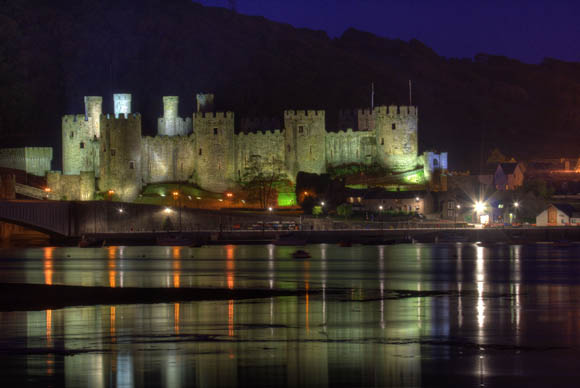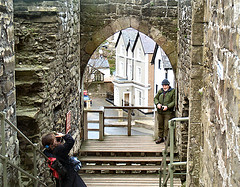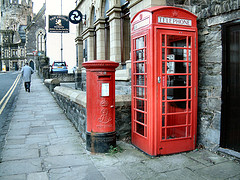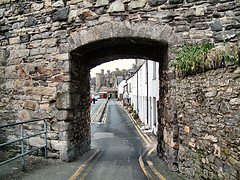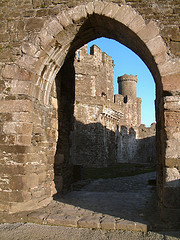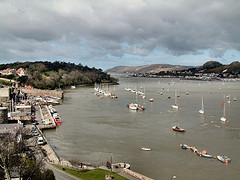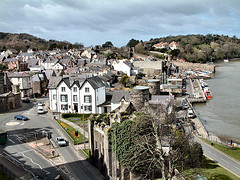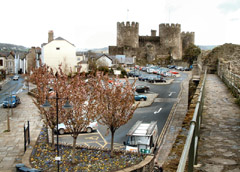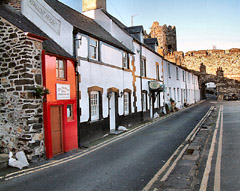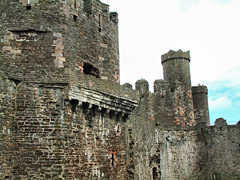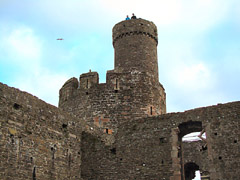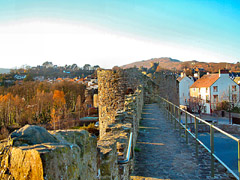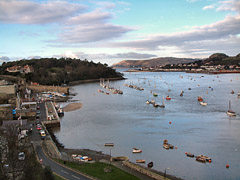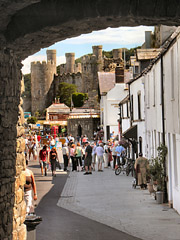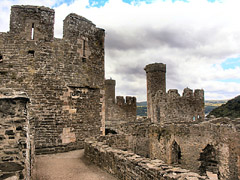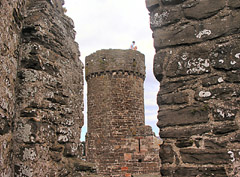Conway, or Aber-Conway (Aber-Conwy) - From 'A Topographical Dictionary of Wales' (1849)
CONWAY, or ABER-CONWAY (ABER-CONWY), a sea-port, a borough, market-town, and parish, and the head of a union, in the hundred of Ll�chwedd Is�v, county of Carnarvon, North Wales, 24 miles (E. N. E.) from Carnarvon, and 224 (N. W. by W.) from London; the parish containing 1358 inhabitants. This place, which was anciently called Caer Gyfin, is supposed to have arisen from the ruins of the Roman station Conovium, in the neighbouring parish of Caerh�n, and derives its present name from its situation near the mouth of the river Conway or Conwy, which falls into the Irish Sea about two miles from the town. The river is thought to derive its name from the two Welsh words, cyn, "chief," and wy, "river;" or "chief river." Of the earlier history of the place, few particulars are recorded. Very little authentic information can be traced prior to the year 1185, when Llewelyn ab Iorwerth, Prince of Wales, founded a monastery here, for brethren of the Cistercian order, which he endowed with ample possessions, and with numerous valuable and important privileges. The abbey continued to flourish unmolested till the reign of Henry III., during whose efforts to repair the fortifications of Deganwy, on the opposite side of the river, to facilitate the subjugation of the principality, it was plundered and partly burnt, about the year 1245, by a body of 300 of his Welsh vassals in the Marches, whom that monarch had despatched to the rescue of a vessel from Ireland, laden with provisions. This vessel, being stranded on the coast, had been attacked by the people of the neighbourhood, who had previously reduced the English soldiers to great distress, by cutting off their supplies. Exasperated at the outrage done to their stately monastery, now become one of the primary objects of their religious veneration, the Welsh rushed down from the mountains, whither they had been driven by the detachment from Henry's army, and suddenly fell upon their assailants, whom they found heavily laden with spoil, slew many of them, forced others into the Conway, where they perished, and took several prisoners, whom they afterwards barbarously put to death, cutting off their heads, tearing their limbs, and throwing their mangled corpses and members into the river. They then again furiously attacked the vessel, which was defended with great bravery and spirit by Sir Walter Bisset, until midnight, when, on the influx of the tide, the Welsh were obliged to withdraw, and Sir Walter and his force, abandoning their dangerous situation, retired to the English camp. In the morning the Welsh returned, and, finding the vessel deserted, took possession of the cargo, almost wholly consisting of wine, and set fire to the ship; so that the English only obtained seven tuns of wine, which they took out of that portion of the vessel not consumed by fire.
In 1277, Edward I. advanced with his army through the level parts of North Wales to Conway; and Llewelyn ab Grufydd, the reigning prince, being compelled to retire among the mountains of Snowdon, soon after agreed to a humiliating treaty of peace, which was concluded at this place. On the next invasion of Wales by Edward, in 1282, he again led his army hither, and stationed it with great advantage in the vicinity, the cavalry being encamped on the plains at the foot of the Snowdon mountains, and the infantry posted on the sides of the hills, under cover of the woods. Having finally reduced Wales under his dominion, the king, in 1283, began to erect a strong and stately castle here, near the site of the ancient monastery, the inmates of which he removed to an abbey he had founded or enlarged at Maenan, on the Denbighshire side of the Conway, but still in Carnarvonshire. He ultimately transferred them, according to some writers, to the celebrated abbey of Vale Royal, in Cheshire, also of his foundation; though it is the opinion of others that they continued at Maenan. The king also, when he raised the castle, or soon afterwards, fortified the town with embattled walls, twelve feet in thickness, which still remain entire, and have a very compact appearance. They are about one mile and a quarter in circumference, being defended by twentyfour towers, and having five principal gates of ancient erection, inclosing an irregular triangular area, and communicating at the south-east angle with the castle, which occupies the summit of an immense isolated rock of compact schistus, on the western shore of the river Conway. This castle, the beauty and magnificence of which are almost unrivalled, forms a noble picture, its imposing interest and effect being much enhanced by the picturesque and diversified scenery with which it is surrounded. After the commencement of these splendid fortifications, Edward, in 1284, incorporated the town, together with others in the principality, granting the inhabitants a charter of privileges equal to those which he had previously bestowed on the inhabitants of Hereford, and appointing a constable of the castle, whom he also made mayor of the borough.
In 1294, this sovereign again came in person into North Wales, at the head of an army, to repress the insurrection under Madoc, an illegitimate son of the late Llewelyn, and, having crossed the Conway with a part of his forces, awaited at the castle the arrival of the remainder. In executing this movement, Edward lost several wagons and other carriages, laden with provisions, which were intercepted by the Welsh, who unexpectedly came down from the mountains, and invested the castle on the land side. The rear of the English army being unable to join the king, in consequence of a sudden rise of the Conway, the latter, hemmed in by a vindictive enemy and an impassable river, was placed in a situation of considerable embarrassment, and the garrison was reduced to much distress for want of provisions. The Conway at last subsiding, the remainder of Edward's army crossed to his relief; and the Welsh, abandoning the siege, retired to the mountains of Snowdon. On their departure the English monarch kept his Christmas here with becoming splendour and without molestation; and the insurgents were shortly afterwards defeated with great slaughter by the Earl of Warwick.
Richard II., whilst in Ireland, appointed this place as the rendezvous of his forces destined to oppose the usurpation of Bolingbroke, afterwards Henry IV.; and 40,000 loyal vassals out of Cheshire and Wales are said to have assembled here, under the command of the Earl of Salisbury, awaiting his arrival. Wearied by broken promises and protracted delays, many of them returned to their homes: still a sufficient number remained to assert the rights of Richard, with promise of success, had not that prince, on his arrival, been persuaded to retire from the place to Flint, under a specious proposal of accommodation with Bolingbroke. From this time Aberconway continued uninterruptedly in the possession of the reigning monarch, and, during the contentions of the houses of York and Lancaster, sustained but little injury. It was repaired by Henry VII., who restored that part of the fortifications which had fallen into decay; and it remained in an entire state until the civil war of the seventeenth century.
In 1643, the castle was garrisoned for the king by Dr. John Williams, Archbishop of York, who was appointed governor; and who, having made his nephew, William Hookes, deputy-governor of the town and castle, was afterwards invested by the king with the office of commander-in-chief of the royalists in North Wales. At this critical period, the castle, from its impregnable strength, was made the depository of the writings, plate, and valuables of the neighbouring gentry, to whom the archbishop gave receipts for the deposits, thus rendering himself responsible for their security. But, in 1645, Prince Rupert, taking upon himself the command of North Wales, superseded the archbishop in his office of commander-in-chief, and displaced his nephew from the governorship of the castle, which he entrusted to Sir John Owen. Deeply offended at this, and apprehending ruin to himself, from his receiving no security for the treasure which had been committed to his custody, the archbishop listened to overtures made to him by some of the opposite party, and, joining with General Mytton, assisted in the reduction of the town, which was taken by storm on the 15th of August, in that year. The castle held out till the 10th of November following, when, after a valiant and resolute defence, it finally surrendered to the parliamentary forces. The archbishop, who, during the action, had been wounded in the neck, was, in consideration of his services, absolved by the parliament from all his sequestrations; and Mytton, with a degree of generosity unusual in those times, restored to every individual the property which he had placed for security in the castle. That general, however, seized on all the Irish whom he found among the garrison, and, causing them to be tied back to back, ordered them to be thrown into the Conway river. The grandeur of the castle obtained for it a due consideration from the captors, no order being issued for its demolition; and at the Restoration it was given up to Charles II., as the only perfect fortified place which had escaped the violence of the parliamentarians. This monarch granted it to Edward, Earl of Conway, by whose order the iron, timber, and lead were taken down and transported to Ireland, in 1665. Against that nobleman's proceedings, the deputy-lieutenants and gentry of North Wales made zealous remonstrances, being anxious to preserve from premature dilapidation an edifice which for four hundred years had attracted the admiration of the country; the order, however, was carried into effect, and this magnificent structure was reduced nearly to the state in which it at present appears. The extensive ruins are noticed at the close of the article.
The town is pleasantly and advantageously situated on the western shore of the river Conway. It comprises one principal street leading to the castle, intersected at right angles by a spacious street extending from the east gate to the marketplace, and by a narrower street of greater length, leading from the continuation of Castle-street on the north to the west gate. The ancient walls, with their towers, are still in good preservation, and the five principal gates are yet remaining: a very considerable portion of the area within the walls is occupied as garden-ground, and the houses are comparatively few and in detached situations. Of the ancient houses is Plas Mawr, an interesting specimen of the domestic architecture of the sixteenth century, the property of the Mostyn family, by whom it is kept in repair: the heraldic devices on the internal walls are in great profusion.
Among the improvements which have taken place in the immediate vicinity of the town, on the line of the Chester and Holyhead road, is the construction of the Suspension-Bridge over the river Conway, under the direction of Mr. Telford, in lieu of the ancient ferry. It was commenced on the 3rd of April, 1822, and opened on the 1st of July, 1826. The chains are fastened, on the east side of the river, in a solid rock, which, before the construction of the bridge, was insulated; while on the west side, after passing under the walls of the castle to a distance of 54 feet, the chains are securely bolted into the rock on which that fortress is built. From the eastern extremity an embankment, 671 yards in length, and 30 feet in breadth at the top, was raised on the sands between the island and the shore; and from the western extremity a road was cut through the solid rock, under the north-east side of the castle, to the distance of 175 yards, to unite with Castle-street; thus making the whole extent of the bridge and its approaches more than 900 yards. On the road a lodge of two towers was erected, corresponding in design with the venerable remains of the castle, and forming an arched entrance from the town to the bridge, through a pair of massive iron-gates of noble appearance. The length of the bridge, between the centres of the supporting towers, is 327 feet; its height, above high-water mark, 18 feet; and the height of the pillars, over which the chains pass, 42 feet from the platform. The principal chains, from which the roadway is suspended, are eight in number, and are formed of links, each consisting of five bars of iron, three inches and a half wide, and one inch thick. Connected with the bridge, a very important improvement was effected in the formation of the road leading from the town through the north-west wall (where a noble gateway was erected) and proceeding round the immense mountain of Penmaen B�ch, along the declivity of which it is carried by an excavation in the solid rock, in some places eighty feet high, and extending nearly a mile in length. The new line of road is more than four miles and a half long from Conway to Brynmor, where it joins the old Holyhead road.
Not far from the suspension-bridge is the great Iron Tubular Bridge across the Conway, forming part of the line of the Chester and Holyhead railroad. This extraordinary structure, whose solidity and weight contrast strikingly with the light network of the suspension-chains of Telford's bridge, is supported on two piers of masonry, one on each bank, and measures in length 424 feet, of which 400 feet are clear between the piers. It seems that the idea of a tube-bridge was first conceived by Mr. Robert Stephenson, the engineer of the railway company; and that, being unable, from his numerous professional engagements, personally to carry out the requisite experiments, he committed this important task to the able hands of Mr. Fairbairn, of Manchester, under his own immediate inspection. Some claims have been made for Mr. Fairbairn with regard to the invention of the bridge; whether well founded or not, it is unnecessary here to determine: without doubt, much credit is due to this distinguished mechanist for the experiments he instituted with a view to ascertain the proper principles on which the structure should be composed. Mr. Stephenson's original conception was, that a tube of circular form would be the strongest; and Mr. Fairbairn accordingly constructed a model on a large scale, containing nearly all the features of the intended tube. This form, however, was found defective in many respects, and the idea of raising a circular bridge was soon abandoned. Tubes were afterwards constructed of elliptical and rectangular shapes, with various results: eventually, a square tube was decided on; and the investigations were now continued, to evolve the principles on which this form might be rendered of sufficient strength to resist vertical and lateral violence. At first, Mr. Fairbairn conceived that the top and bottom of the tube should consist of a series of pipes arranged in a hollow apartment, covered above and below by iron plates riveted together, and having a parallel direction with the long axis of the tube. Thus, great rigidity would have been communicated to the top, to resist the immense compression that it would have to endure; and the bottom would have been equally strong, to resist the tension to which it would be subject. This design would probably have been adopted, but for several serious practical difficulties that presented themselves to its construction, and to its repair if accidentally damaged. The model tube was finally formed with longitudinal cellular compartments, of a square shape, at the top and bottom. It was eighty feet long, four feet six inches deep, two feet eight inches wide; and rested on two supports, the distance between which was seventy-five feet: the total weight was between four and five tons. This large model was subjected to severe experiments, to test its strength; a great weight was attached to its centre, and increased ton by ton, the deflection being carefully noted, together with the entire weight of the load. After three experiments, in which various defects were discovered, the conclusion arrived at of the extreme point of resistance of the model tube placed it at about fiftysix tons; a result exhibiting the extraordinary resistance offered by such a structure to a load more than eleven times its own weight. The principle of the proposed bridge was thus satisfactorily determined, and the accuracy of the engineer's conjectures as to this new method of bridge-building was fully established.
The erection of the bridge was commenced in the early part of 1847, the scene of operations being about 100 yards from the intended site, which was not convenient for the works. Advantage was taken of a less precipitous part of the river's bank, where a piece of level ground projected some distance into the stream; here workshops and a steam-engine were erected, and an immense platform was constructed on piles driven into the ground, and partly into the bed of the river, forming a temporary pier. The design comprised two tubes, exactly similar, to cross the Conway parallel with each other as one grand bridge; the one tube for the trains from, and the other for those to, Chester. The first tube was at length completed, and there remained only the task of drawing it to its right position, and raising it to a level with the railway: this, however, was an operation the most anxious and arduous perhaps of the whole undertaking. The work was effected in March 1848, after a lapse of about a twelvemonth from the commencement of the bridge. The tube had been made to rest upon two temporary stone piers, by the removal of some of the piles supporting the platform on which it stood; and six immense pontoons, 100 feet long, and of proportionate breadth and height, were hauled up to the platform on the day appointed, and floated, three at each end of the tube, underneath it. As the tide rose higher and higher, the pontoons rose too, until they touched the bottom of the tube, and began to bear up its tremendous weight; pumps were then set to work, and the pontoons emptied of a large volume of water that had been purposely introduced into them. When this water was discharged, they rose still higher, till at length the immense mass floated clear off the platform on which it had been built. It was now drawn towards its proper site by means of strong hawsers worked by capstans, and attached to different places; its course being guided by chains connected with buoys fixed at intervals in the route. Then resting, under the receding influence of the tide, on stone beds prepared for its reception, it appeared as a great unwieldly chest crossing the transparent waters of the river, and offering a barrier to navigation. The next operation was, to uplift the tube about twenty-four feet to its permanent elevation; this was done by steam-engines and hydraulic rams erected at its ends, and the structure then spanned the stream, perfect in all its parts, a monument of the combined skill of British engineers of the nineteenth century. It was finally adjusted on April 17th; on the following day an engine passed through it several times, and on the 19th Mr. Stephenson and the directors of the company passed through, without the slightest vibration being felt, or any deflection being observed. The second tube, parallel with this, and with it forming one splendid bridge, was completed in November 1848.
The length of the bridge, as already stated, is 424 feet: each tube is fourteen feet in width throughout, twenty-two feet three inches high at the ends, and twenty-five feet six inches in the middle; the weight of each, about 1300 tons. The tubes are constructed of wrought-iron plates from four to eight feet long, and two feet wide: the thickness of those which enter into the formation of the sides is diminished towards the extremities to five-eighths of an inch. The plates are firmly riveted together to T-angle iron ribs on both sides of the joints, and the beautiful regularity of the rivets gives to the structure somewhat of an ornamented appearance. The ceiling of the tube is composed of eight cellular tubes, each of them about twenty inches wide, and twenty-one high; these are formed of wrought-iron plates threequarters of an inch thick in the middle, and half an inch towards the ends, of the tube. In the floor are contained six cellular tubes, about twentyseven inches wide and twenty-one high, formed like those of the ceiling, with the addition of a covering plate of iron over every joint on the under side of the tube. The sides are united to the ceiling and floor by double angle irons within and without. One end of the tube is fixed to the masonry of the pier, but the other end is so arranged as to allow for the expansion of the metal by the action of atmospheric variations. It therefore rests upon eleven iron rollers, running on a bed plate; and in order that its whole weight may not bear upon the rollers, six girders are carried over the tube, and riveted to the upper parts of its sides, these side portions resting on twelve balls of gun-metal running in grooves, which are fixed to iron beams let into the masonry. A concise account of the bridge is given in a recent number of "Chambers' Edinburgh Journal," from which most of the foregoing particulars are abridged. Approaching from Chester, the railway passes along an embankment near the road leading to the suspension-bridge, and the elegant towers of that structure are seen by the traveller, together with the more massive masonry of the railway bridge. On emerging from the tube, the train proceeds beneath the walls of the ancient castle, and then through the town walls, to the Conway station, a neat edifice in the Tudor style. Further particulars of the line will be found under Holyhead and Bangor, and in the articles on the counties through which it passes.
Conway is a creek to the port of Beaumaris; but, notwithstanding the natural advantages of its situation, and the great improvements in its immediate vicinity, there is no trade of importance. The river, which, considering the shortness of its course, not exceeding twenty-four miles, is perhaps one of the noblest to be found in any country, is here navigable for vessels of 200 tons' burthen, and forms under the town wall an excellent harbour, in which ships may ride in safety. There is also an extensive and commodious quay, lately much improved by the corporation, affording every facility for loading and unloading goods. Still, the commerce of the port is almost confined to the importation of coal and groceries, and the exportation of timber, corn, slates, &c., principally to Liverpool. The Conway is celebrated for the pearl muscle, which is produced in great abundance; and formerly the pearl fishery was carried on here to a very considerable extent: at present about forty persons are employed in the fishery, which produces, on an average, 160 ounces per week. The pearls are equal to those found on any part of the British coast; they are generally sold at the rate of 2s. 6d. per ounce, and as much as �400 or �500 has been paid for them in a year. The market is held weekly, on Friday. The fairs are as follows: the clover-fair, held on the 26th March; the woolfair, on the 20th June; the honey-fair, on the first Friday after the 4th September; and the butterfairs, on the first Friday after the 16th October, and after the 15th November. The September fair is supplied with a considerable quantity of honey, of a superior quality, from the glens of the adjoining mountains.
The borough appears to have been incorporated by Edward I., in the 12th year of his reign, about the period of the foundation of the castle. The charter bestowed by this monarch was confirmed in the 5th of Edward III., 2nd of Richard II., 4th of Henry VI., 5th of Edward IV., 2nd of Richard III., 4th of Henry VII., 1st of Henry VIII., and perhaps in the 1st of Edward VI.; but with respect to this lastnamed charter, of which no certain account is known, it is doubtful whether it was ever actually passed or not. In the 9th year of his reign, Edward II. granted to the burgesses of Aberconway, the town, two mills, &c., in fee farm, at the yearly rent of fifty marks, �33. 6. 8. The style of the corporation is "the Mayor, Bailiffs, and Burgesses of the town and borough of Conway;" and the government is vested in a mayor, two bailiffs, a recorder, a coroner, a treasurer, two sergeants-at-mace, a water-bailiff, a gamekeeper, four borough constables, and two churchwardens, all of whom, with the exception of the mayor and recorder, are chosen annually by the burgesses. The mayor, who is mayor as constable of the castle, receives his appointment from the crown, with a salary of �23 per annum; he presides at parliamentary elections, and attends the meetings which are held for choosing corporate officers on Michaelmas-day. The bailiffs act as lords of the manor, control the police, and preside in the court baron and court leet. The recorder, who holds his office for life, keeps the courts, and swears the constables; and the coroner, treasurer, and other authorities perform the usual duties annexed to their offices. The number of "burgesses" is about forty, elected by the burgesses at large. The corporation, who are lords of the manor and claim all wastes, possess the marsh, which produces about �100 a year, the town mountain, Mynydd y Dre, and other property, the whole yielding about �230 per annum; they possess jurisdiction over the entire parish, with portions of three others, and the circumference of the borough is about eighteen miles.
This is one of the six contributory boroughs within the county, which unite in returning one member to parliament. The right of election, which was formerly in the burgesses at large, is now vested in such persons as occupy any house or other premises, either as owner, or as tenant under the same landlord, of the clear annual value of not less than �10, provided they are capable of registering their names as the act requires: the number of voters is about sixty. The freedom is obtained only by gift of the burgesses at large, who generally present it to persons living out of the borough, and mostly at a considerable distance. The corporation have power by their charter to hold courts of sessions for the trial of all offenders not accused of capital crimes, but they have not for many years exercised it. A court of requests, the jurisdiction of which was coextensive with the borough, and at which the recorder presided, used to be held every third week, on Thursday, for the recovery of debts under forty shillings; and courts leet and baron are still held. A lock-up house was erected at the expense of the corporation, upon the destruction of the old building, when the suspension bridge was built. The general quarter-sessions for the county were formerly held here by adjournment, but for many years past they have been held at Carnarvon: the county magistrates hold a petty session for the division in the townhall, on the first Friday in every month; and one of the county debt-courts established in 1847 has been fixed here, its powers extending over the Conway registration-district.
The parish is bounded on the north by that of Eglwys-Rh�s, on the south by Gyfin, on the east by Llansantfraid-Gl�n-Conway in Denbighshire, and on the west by Dwygyvylchi. It comprises about 632 acres, exclusive of mountain land, plantations, and 316 acres of marsh; the ground is undulated, and surrounded by high hills, among which are the town mountain, Penmaen, and Tootil hills. Besides the Conway, the rivers Gyfin and Avon-y-wain water the parish, and, with the expanse of Beaumaris bay, greatly contribute to enliven and enrich the scenery. The beautiful seat of Boddlondeb, the property of Lady Erskine, is situated in a lovely and richly wooded spot, commanding fine views of the river Conway, as well as of the castle.
The living is a discharged vicarage, rated in the king's books at �7. 7. 6., endowed with �600 royal bounty, and in the patronage of Lady Erskine; net income, �121. The church, dedicated to St. Mary, is a spacious and venerable structure, containing portions of Norman architecture; it is 116 feet in length and 58 in breadth, and will accommodate about 500 persons. The building contains some curious monuments, among which are, one to the memory of Nicholas Hookes, of Aberconway, Gent., whose epitaph represents him to have been the fortyfirst child of his father, Wm. Hookes, Esq., by Alice his wife, and the father of twenty-seven children; and a rude effigy of Mary, the mother of Archbishop Williams: among the several other relics of antiquity is a richly carved oaken screen. There are places of worship for Independents, Calvinistic Methodists, Wesleyans, and Baptists. A school for boys, and one for girls and infants, have been established in connexion with the Church; and five or six Sunday schools are supported, most of them by the dissenters. Lewis Owen, in 1623, bequeathed in trust the rectorial tithes of Conway, producing at present �120 per annum, half to be expended in clothing the poor of the parishes of Conway, EglwysRh�s, Llancystenyn, and Llandudno; the other half to be given to the vicar of Conway. There are a few trifling bequests for the distribution of money and bread among the poor; and two or three small charities have been lost. The poor-law union of which this town is the head, was formed on the 11th of April, 1837, and comprises the fifteen parishes and townships of Caerh�n, Conway, D�lgarog, Dwygyvylchi, Eglwys-Rh�s, Eireas, Gyfin, Llanbedr, Llancystenyn, Llandrillo-yn-Rh�s, Llandudno, Llanelian, Llangelynin, Llansantfraid-Gl�n-Conway, and Llŷsvaen. It is under the superintendence of fifteen guardians, and contains a population of 10,706, of whom 7906 are in Carnarvonshire.
Of the monastery founded by Prince Llewelyn, there are no remains. The founder was interred within it in 1240, but on its dissolution, after Edward I. had removed the monks to Maenan, a few miles higher up the river, Llewelyn's remains were conveyed first to Maenan, and thence, after the dissolution of that abbey, to Llanrwst, where the stone coffin in which they were deposited is now preserved. In the conventual church was also interred Cynan ab Owain Gwynedd, in the year 1200, in a monk's cowl, from a superstitious belief that by such means the soul would be preserved from punishment. It was also the burial-place of Davydd ab Llewelyn, Prince of North Wales, son of the founder, who died in 1246, and of his brother Grufydd, who died a prisoner in the hands of Henry III., and whose body was given up, about the year 1248, at the urgent solicitations of the abbots of Aberconway and Strata Florida, for interment in this abbey, which was then considered the mausoleum for the princes of North Wales.
The extensive ruins of the magnificent castle comprise an irregular parallelogram, divided into two wards, of which the smaller is square. The walls, which are sixteen feet in thickness, are defended by eight circular embattled towers, nearly equidistant, and of prodigious strength: from the summits of four of them, which overlook the river, rise circular embattled turrets, of slender proportions and of great beauty. The principal entrances were from the river and the town: the former consisted of a narrow winding ascent up the steep rock, terminating in an advanced work fronting the gate of the castle, and protected by small round towers; and the latter, which was similarly defended, was approached by a drawbridge over a large fosse. The keep and other fortifications are massive and of considerable dimensions, and the state apartments exhibit good specimens in the decorated style of English architecture, of which the details are peculiarly fine; among these, an oriel window in one of the great towers appears to have been a beautiful composition. The great hall is 130 feet long, and thirty-two feet wide: the roof, which is proportionably lofty, was supported by a series of noble arches, of which several still remain; and the whole apartment was lighted by a range of six large windows on the one side, commanding a view of the country, and of three on the other, looking into the court, with a window at the eastern end, having a circular head. As a royal residence and as a fortress, this interesting and extensive pile was conspicuous for its beauty and its strength; and the ruins, which convey an impressive idea of its former importance, are among the most magnificent and imposing in the kingdom. The inhabitants many years since, by imprudently getting stones from the rock beneath one of the great towers, undermined it, and brought down the lower portion, the fragments of which form a vast heap of ruins on the shore; the upper part of the tower is left entire, suspended from a great height, and exhibits in the breach such a degree of strength and solidity as might almost have defied the ravages of time. In the vicinity of the town are numerous encampments, but none within the limits of the parish, which comprises comparatively a small area. Archbishop Williams was a native of Conway, and the apartment in which he was born is still shown: when governor of the castle, he built a house here, in which his arms, impaling those of York, are yet preserved. |

